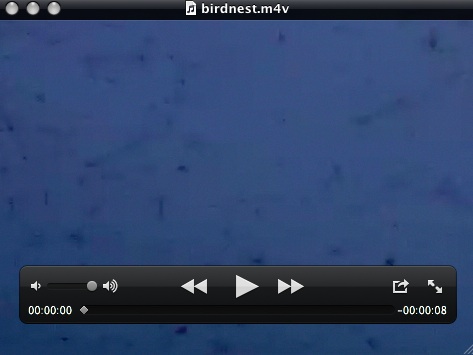
A Bird in the Hand
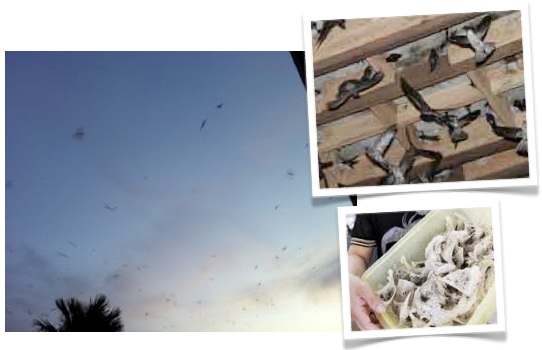
Harvesting Swiftlets (collocaliini) are tiny insectivorous birds that are distributed from the Indian Ocean, through Southeast Asia including Thailand, Malaysia, Vietnam, the Philippines and Indonesia and North Australia to the Pacific. The small birds eat insects only and catch these insects on the fly as they fly from nearly first light until nearly dark. Amongst various species of swiftlets in the genus of Collocalia, only the nests of four species mostly spread throughout Southeast Asian region have commercial value because of human consumption. They are Collocalia fuciphaga, Collocalia germanis, Collocalia maxima and Collocalia unicolor. Collocalia species are relatively small and average 6.5g in weight, and have glossy plumage. Each of these species produces nests with salivary glue, a cementing substance, although other materials such as vegetation or feathers may also be utilized. It takes the bird about 20-35 days to finish the nest. The nests take the shape of a shallow cup stuck to the cave wall. The nests are composed of interwoven strands of salivary laminae cement. Nests have high levels of calcium, iron, potassium, and magnesium. The edible bird's nests ( 燕窩 in Chinese) made up of pure salivary glue are much more expensive than those incorporating other materials. These nests with other materials are considered seconds or lesser valued. According to reports, the most heavily harvested nests are from the Edible-nest Swiftlet or White-nest Swiftlet (Aerodramus fuciphagus) and the Black-nest Swiftlet (Aerodramus maximus). The white nests and the "red blood" nests are supposedly rich in nutrients which are traditionally believed to provide health benefits, such as aiding digestion, raising libido, improving the voice, alleviating asthma, improving focus, and an overall benefit to the immune system. 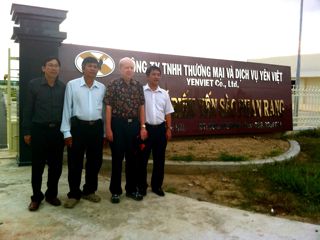 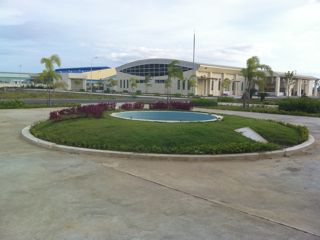 (Pictures
above) Mr. Vo Thai Lam,
Chairman and General
Director, Yen Viet (far right), author,
Mr. Nguyen Van Be and Yen Viet's Nha Trang Manager in front of Yen Viet's sign in a modern industrial park in Ninh Thuan (see our article on Ninh Thuan) The Business of Producing and Bringing to Market Bird’s Nests China, Hong Kong and Taiwan are the largest importers of these nests. In Hong Kong a bowl of Bird Nest Soup would cost $30 USD to $100 USD. A kilogram of white nest can cost up to $2,000 USD, and a kilogram of "red blood" nest can cost up to $10,000 USD. The white nests are commonly treated with a red pigment, but methods have been developed to determine an adulterated or altered nest. The nests were formerly harvested from caves, principally the enormous limestone caves at Gomantong and Niah in Borneo. With the escalation in demand these sources have been supplanted since the late 1990s by purpose-built nesting houses, usually reinforced concrete structures either in the form of shop houses, theaters, etc. These nesting houses are normally found in urban areas ajoining the sea, since the birds have a propensity to flock in such places. This industry has transformed many towns in the Indonesian Province of North Sumatra as well as limited areas in Vietnam, Thailand and the Palawan area of the Philippines. Birds nests from the more progressive companies like Yen Viet Company in Vietnam which collects birds nest from multiple sites in Khanh Hoa, Ninh Thuan and other provinces in Vietnam are harvested in an ecologically sustainable way. The birds are nurtured and the nests are never removed while the eggs or small birds are present. From Vietnam, Indonesia, Thailand and elsewhere the nests are mostly exported to Hong Kong, which has become the centre of the world trade, though most of the final consumers are from mainland China. In Indonesia, the importance of this trade has become very large. It has been estimated that the products now account for 0.5% of the Indonesian GDP, equivalent to about a quarter of the country's fishing industry. Health Benefits of Bird’s Nests The medicinal use of edible bird's nest can be traced back to the 17th century but maybe even earlier. In Hong Kong and in Chinese diaspora locations throughout the world, traditional Chinese medicine (TCM) is often used to treat diseases and enhance health. It is believed that TCM herbs have wide-ranging effects for enhancing health, lowering risk of diseases and promoting life span. Being one of the TCMs, edible bird's nest is believed to have health enhancing effects such as anti-aging, growth promoting and immuno-enhancing properties. However, unlike other traditional medicine materials edible bird's nest is different from most of the TCMs. It is unique in that it is not only a medicine to make people healthy but also a pleasant food to be consumed and enjoyed. Traditionally, it is double boiled with rock sugar to make a delicacy known as "bird's nest soup". The gelatin drink that is served in small glass bottles also is processed with rock sugar and has a slightly sweet taste. Although the size of Collocalia bird is small, the market generated by it is quite large and growing at double digit rates. Malaysia is the world's third largest supplier of birds' nests after Thailand and Indonesia, contributing 10 percent of the 210 tonnes, worth up to $4 billion US dollars, consumed annually by top buyers in China and Taiwan. The size and importance of this market is huge for all of these countries. For example, today there are 40,000 swallow houses in Malaysia with some 8,000 people taking part in swallow farming activities. Also according to the Malaysian Federation of Bird’s Nest Merchants Association Malaysia's annual production of bird's nests had reached 1 billion ringgit (290 million U.S. dollars) in value and was expected to hit 5 billion ringgit (1.47 billion U.S. dollars) in another five years. In Vietnam, many of the bird’s nest companies earn millions of US dollars in sales of their products which have a good reputation both domestically and internationally. For example, Yen Viet Trading and Service Limited Company which is based in Ninh Thuan but has a total of 18 locations throughout the country where they raise the birds and harvest the nests achieves sales of over US $5 million per year of which 30 percent are from exports. Mr. Vo Thai Lam, Chairman and General Director, of the company has achieved a very high level of return based on his reverence for the birds and his constant willingness to put their well being ahead of short term profits. This approach has borne results in Vietnam and already Yen Viet is a leading brand in Vietnam and yearly increases its sales internationally in Hong Kong, Taiwan, China and elsewhere. Why is Hong Kong the leading consumer of birds nests? It may be due in part to the fact that Hong Kong people are increasingly concerned about their health and the status of TCM has risen after a series of government policies on TCM. Moreover, the dual nature of edible bird's nest, which utilizes them both as medicine and/or food, may play a role as food in centrally linking cultural pastime in Hong Kong. In the past, people could only buy dried edible bird's nests and render them in a fairly time consuming process. This has changed and currently a large variety of edible bird's nest related products have emerged in the market. These products are mostly ready to serve products. No cooking process is required. Amongst these new products, most of them are still in the traditional form as bird's nest soup, such as instant bird's nest in different concentrations. Some instant bird's nest may also be supplemented with other TCMs. Apart from the traditional form, there is a trend of using edible bird's nest extract as one of the chief ingredients of the products. These products focus mainly on the medicinal use of edible bird's nest. However, some of them may exaggerate the evidence of therapeutic use of edible bird's nest. For the limited supply and high price of edible bird's nest, it is not uncommon to hear reports of fake edible bird's nest in the market. The imitation substitute commonly used is the edible plant-exude, gum karaya or sterculia. Recently, there are reports of fake edible bird's nest made from fishes' skin, mushroom or algae in China. Because of these reports, there are increasing concerns on authenticating the genuineness of edible bird's nest. 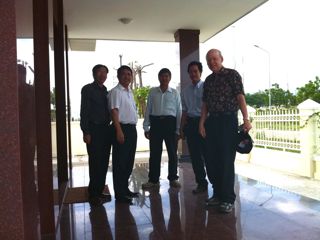  (Picture
left) Management of Yen Viet, Mr. Be, the Author and Mr. Bui Tuong Minh
of Runckel & Assocites
outside the company's Phan Rang main office. (Picture right) The Parents of Mr. Vo Thai Lam who now live in the U.S. and are proud proponents of the health aspects of bird's nests. Authenticity of Edible Bird's Nest In recent years, there has been increasing reports of fake edible bird’s nests. Starting in the 1990s, the first comprehensive report on authentication of edible bird's nests were published. These reports demonstrated the possibility to use scanning electron microscopy, energy dispersive X-ray microanalysis, flame atomic emission spectroscopy, inductively coupled plasma-atomic emission spectroscopy, ultraviolet-visible spectroscopy and other physico-chemical techniques to determine the authenticity of edible bird's nest. These tests were difficult to run, expensive and only worked on some of the substances used to imitate birds nests. Recently, a China based research team developed a simple but accurate and reliable spectrophotometry method to determine edible bird's nest content. The method is based on the reaction between N-acetylneuramic acid and ninhydrin in acid solution. The method evaluates the internal content of N-acetylneuramic acid, a nine-carbon sugars, which is one of the major components in edible bird's nest. Nutritional Content and Medicinal Use Edible bird's nest contains mainly amino acids, carbohydrates and mineral salts. The major ingredients of edible bird's nest are glycoproteins. Amongst the carbohydrates in edible bird's nest, sialic acid (9%) is the major one. It was found that exogenous source of sialic acid may contribute to neurological and intellectual advantages in infants[12]. However, the nutritional and biological mechanisms of sialic acid in human body are still under investigation. The other major carbohydrates include 7.2% galactosamine, 5.3% glucosamine, 16.9% galactose and 0.7% fucose. Amino acids and mineral salts are also important components in edible bird's nest. Three non-essential amino acids (aspartic acid, glutamic acid, praline) and two essential amino acids (threonine and valine) can be found[11]. They could facilitate normal body functions such as cell repair and promote immunity. Edible bird's nest is rich in mineral salts. It contains high content of sodium and calcium. It is because the source of edible bird's nest is derived from saliva Collocalia inhabiting mainly in limestone caves. In addition, low levels of magnesium, zinc, manganese and iron are also detected in edible bird's nest[8]. In spite of the long history of using edible bird's nest for medicinal purposes, there is not much scientific research related to the therapeutic use of bird’s nest. The earliest recent scientific evidence was given by Ng et al. (1986) in Hong Kong. Edible bird's nest aqueous extract was found in his studies to potentiate mitogenic response of human peripheral blood monocytes to stimulation with proliferative agents, Concanavalin A and Phytohemagglutinin A. The results of this research suggested that edible bird's nest might possess immunoenhancing effect by aiding cell division of immune cells. One year later, other scientific evidence was published by Kong et al. This study demonstrated an epidermal growth factor (EGF)-like activity in aqueous extract of edible bird's nest that stimulated the DNA synthesis in 3T3 fibroblast in a dose dependent manner in vitro. EGF is a 6,000 Da polypeptide hormone produced by glands of the gastrointestinal tract, namely the salivary and Brunner's glands. It appears to play a crucial role in major normal cellular processes such as proliferation, differentiation and development. It may offer a rationale for the medicinal use of edible bird's nest in ageing resistance. Since the receptor for EGF is highly expressed in a number of solid tumors, including breast, head-and-neck, non-small-cell lung, renal, ovarian and colon cancer, people are worried about a possibility to induce tumor progression and to resist chemotherapy/radiation treatment in tumor cells; in consequence, suggest that cancer patients should avoid edible bird's nest. In fact, there is no evidence supporting this suggestion. Currently we have evaluated the effects of aqueous extract of edible bird's nest on the viability on two human cancer cell lines, human breast cancer MCF-7 (ATCC HTB-22) and human liver cancer HepG2 (ATCC HB-8065). There was no observable effect on cell viability when comparing with the control group (unpublished data). In 1994, a research team in China, evaluated the pharmacological effects of edible bird's nest and pearl powder containing formulation. The formulation was demonstrated to have immuno enhancing effects by elevating DNA synthesis of T-lymphacytes and circulating immunoglobulin M content in mice. In addition, the formulation also showed ageing retardation by increasing the level of superoxide dimutase. However, the study did not explore whether the effects came from either edible bird's nest, pearl powder or both. Further Studies Edible bird's nest has been used for hundreds or more probably thousands of years. Despite this, scientific evidence for its efficacy is still limited. The claimed health benefits such as resisting aging and improving immunity of edible bird's nest is yet to be conclusively proven. Recently, groups in Hong Kong and more recently in Vietnam, led by Ong Ba Dat Phen, Mephydica and Delphi Health Service are conducting modern biotech and biochemical research on Vietnamese birds nests to better document the health promoting qualities and to better understand the science. This research is being supported by modern birds nest raising companies like Yen Viet who know that the secrets of birds nest need to be better understood and documented and who are always trying to improve and enhance the consumers experience. Read
our related article:
About the Author: Christopher W. Runckel, a former senior US diplomat who served in many counties in Asia, is a graduate of the University of Oregon and Lewis and Clark Law School. He served as Deputy General Counsel of President Gerald Ford’s Presidential Clemency Board. Mr. Runckel is the principal and founder of Runckel & Associates, a Portland, Oregon based consulting company that assists businesses expand business opportunities in Asia. (www.business-in-asia.com) Until April of 1999, Mr. Runckel was Minister-Counselor of the US Embassy in Beijing, China. Mr. Runckel lived and worked in Thailand for over six years. He was the first permanently assigned U.S. diplomat to return to Vietnam after the Vietnam War. In 1997, he was awarded the U.S. Department of States highest award for service, the Distinguished Honor Award, for his contribution to improving U.S.-Vietnam relations. Mr. Runckel is one of only two non-Ambassadors to receive this award in the 200-year history of the U.S. diplomatic service. |
